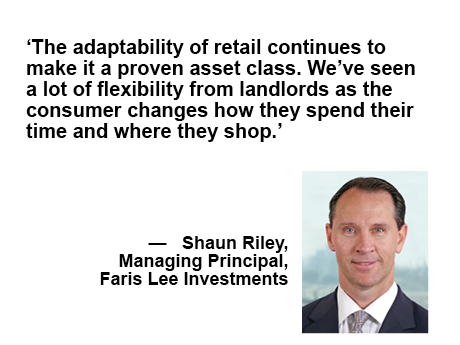The three managing principals at Irvine, Calif.-based Faris Lee Investments — Shaun Riley, Jeff Conover and Don MacLellan — see retail as the best investment class today. The reason? Strong fundamentals across the board, including low vacancy rates, minimal new construction and strong tenant sales.
The trio live in the same world as the rest of us, where interest rates and economic uncertainty have deterred many, but to them, the fact remains that retail has never been stronger as an asset class.

Faris Lee
“People say it’s a bad market. It’s not a bad market,” says MacLellan. “People are confusing the impact of interest rates on returns with retail as an asset class. Fundamentally, retail as a product type is strong, and investors can achieve higher cap rates than we have seen in years.”
Retail Fundamentals
In terms of sales, retail is doing quite well. The Census Bureau notes total retail sales were nearly $1.8 trillion in the second quarter of 2023, with brick-and-mortar sales representing 84.6 percent of all sales. This number was virtually unchanged from the first quarter but was up more than $20 million from the second quarter of 2022.
“We continue to see strong retailer sales,” MacLellan says. “Also, unemployment is very low, so the economic drivers are still fundamentally strong at this point.”
MacLellan notes that retailers themselves are also diversifying. Kohl’s brought Sephora into its stores, for example, while Chipotle is driving much of its traffic through its app.
“Retailers are doing things to bring customers back in store,” he says. “Even if it’s just to drop off an Amazon box, brick and mortar is here to stay. With adapted tech, bricks and clicks are now the best of both worlds.”
Riley believes much of today’s retailer success can be attributed to a sink-or-swim mentality during the pandemic. This forced retailers that wanted to survive to get efficient, adapt and ensure their operations were prepared for the new normal.
“The retail class has really improved since COVID,” he says. “It made retailers change their business models. They emerged stronger and more productive. Those that didn’t, fell into bankruptcy, which gave the growing concepts in each retail segment an ideal opportunity to expand into seldom-seen availabilities in high-quality locations, providing an environment of ‘welcomed vacancies.’”
Real Estate Fundamentals
“Welcomed vacancies” isn’t a term you hear often in real estate, particularly in retail. However, with the current market being what it is — which includes a supply and demand imbalance in terms of space — both landlords and retailers welcomed these closures.
“In the past, a bankruptcy would’ve been seen as a negative,” MacLellan adds. “Now, it’s a positive because there is a lack of junior anchor space for the expanding retailers. Retail square foot per capita remains at an all-time low because there haven’t been any new developments. It’s one of the reasons this is the healthiest market we’ve ever seen.”
Even larger spaces from faltering players like Bed Bath & Beyond, Party City and Tuesday Morning have been easily gobbled up. Landlords are seeing better credit and stronger performing retailers backfill spaces, including Sprouts Farmers Market, HomeGoods and Burlington.
“The adaptability of retail continues to make it a proven asset class,” Riley says. “We’ve seen a lot of flexibility from landlords as the consumer changes how they spend their time and where they shop. This includes the medical and retail (or medtail) trend. By diversifying their tenant roster, landlords can create a captive audience where, instead of a shopper visiting one tenant, they’re suddenly visiting three.”
Investment Fundamentals
With strong sales, occupancy and leasing momentum, Riley is confident in retail real estate as an investment. Though high interest rates persist, they have, in some ways, brought opportunities to the market.
“We’ve seen prices drop from 2022 highs,” he explains. “And more inventory is coming to the market as some investors are motivated to sell due to issues with refinancing going forward. Many are deciding to liquidate some of their portfolios that they thought they’d be holding onto for four to five years.”
Riley notes there’s about a 25-basis point discount on single-tenant net lease investments (STNL) and up to a 100-basis point discount on multi-tenant and unanchored shopping centers.
“We’ve also seen more off-market inventory than at any time in the past several years,” he continues. “That tells us there’s more to come. We feel there will be even more sale opportunities in the next six to 12 months.”
Conover sees the best opportunities for retail investment occurring in the Sunbelt states, from southeast Georgia through Texas and Arizona. He’s also witnessed a trend toward tax-free states, including Florida, Texas and Tennessee.
Product-wise, the most popular asset remains STNL, with Dutch Bros., Starbucks, Raising Cane’s and Chick-fil-A being the most sought-after tenants. Naturally, long-term credit tenants are also garnering attention due to their stable nature.
Just as vacant big box spaces have been in demand for their ability to be divided, so, too, have certain centers.

Faris Lee
“Value-add, high-yield strip centers — anchored or unanchored — provide great investment opportunities,” Conover says. “The value-add component is through future leasing or parceling. Once a center is purchased, you can divide it into different parcels, then sell them as parts — resulting in lower cap rates and smaller price points, which will attract a larger buyer pool.”
As one might imagine, cash buyers are another in-demand item in this market.
“Cash is king,” Conover adds. “You’ll get your best deal as a buyer by paying all cash, and you’ll get a far better ROI.”
Conover notes that many lenders are shut down right now, while those that aren’t require at least 50 percent down.
Many deals are also structured differently than normal nowadays.
“We’re doing due diligence upfront with buyers,” Conover says. “We’re giving them all the information. Then, once they feel comfortable, they’re signing a purchase agreement and executing a quick close. It’s out of order. We’re going in reverse to get the transaction closed.”
This deal structure ensures a smooth transaction, the team notes, as buyers are given everything they need to feel comfortable moving forward before anything actually moves forward — saving time, energy and, most of all, money.
Riley notes that, despite media reports, the team doesn’t see doom and gloom for investment sales anytime soon. It’s not 2008. There continues to be liquidity in the market. Fundamentals — every which way you look at them — are healthy.
“We don’t see the market dropping off a cliff by any means,” he says. “There’s a lot of capital out there and equity in the market. If deals are priced right, they’re selling despite the challenges in the financial markets. We’re getting multiple bids and offers on many of our listings. While we see some potential softening to continue, we feel there are good entry points in this market. An investor can be comfortable purchasing where they need to be and be set up to meet their investment objectives.”
— By Nellie Day. This article was written in conjunction with Irvine, Calif.-headquartered Faris Lee Investments, a content partner of Shopping Center Business.


